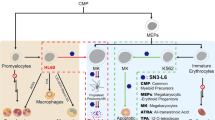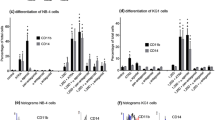Abstract
The oligosaccharide-anthracyclines, aclacinomycin A, marcellomycin and musettamycin, are potent inducers of erythroid differentiation in hemopoietic cell lines of rodent and human origin. The present studies revealed that pyrromycin, a closely related monosaccharide-anthracycline, induced erythroid differentiation in Friend leukemia cells and in the human leukemia cell line K 562. Pyrromycin, marcellomycin and musettamycin, which possess an identical aglycone structure containing a Cl-hydroxyl group, exhibited relatively low optimal inductive concentrations. In contrast, the optimal inductive concentration of aclacinomycin A, which lacks the Cl-hydroxyl group, was markedly higher, i.e., the differentiation inducing capacity was lower. It should be noted, however, that the yield of differentiated cells following treatment with the monosaccharide-anthracycline pyrromycin was distinctly lower than that after treatment with the oligo-saccharide-anthracyclines, aclacinomycin A, marcellomycin or musettamycin. Thus, our data indicate that the efficacy of anthracyclines to induce erythroid differentiation is related to a) the presence of a Cl-hydroxyl group in the aglycone and b) the presence of an oligosaccharide side chain.
Similar content being viewed by others
Abbreviations
- Hb:
-
hemoglobin
References
BACCARANI, M. and RURA, S. (1979). Differentiation of myeloid leukemia cells: New possibilities for therapy. Br. J. Haemat. 42:485–490.
BACHUR, N.R., GORDON, S.C. and GEE, M.Y. (1978). A general mechanism for microsomal activation of quinone anticancer agents to free radicals. Cancer Res. 38:1745–1750.
BERNSTEIN, A., HUNT, D.M., CRICHLEY, V. and MAK, T.W. (1976). Induction by Ouabain of hemoglobin synthesis in cultured Friend erythroleukemia cells. Cell 9:375–381.
BLOCH, A. (1984). Induced cell differentiation in cancer therapy. Cancer Treat. Rep. 68:199–205.
CASTAIGNE, S., DANIEL, M.T., TILLY, H., HEVAIT, P. and DEGOS, L. (1983). Does treatment with ARA-C in low dosage cause differentiation of leukemic cells? Blood 62:85–86.
CROOKEE, S.T. (1979). Biochemical effects of drugs on the cell nucleus. In: Effects of Drugs on the Cell Nucleus (H. Busch, S.T. Crooke and N. Daskal, eds.), pp. 127–143. Academic Press, New York, London.
CROOKE, S.T., DUVERNAY, V.H., GALVAN, L. and PRETAYKO, A.W. (1979). Structure-activity relationships of anthracyclines relative to effects on macromolecular synthesis. Mol. Pharmacol. 14:290–298.
DI MARCO, A. and ARCAMONE, F. (1975). DNA complexing antibiotics: Daunomycin, adriamycin and their derivates. Arzneim.-Forsch./Drug-Res. 25:368–375.
DUVERNAY, JR., V.H., PACHTER, P.A. and CROOKE, S.T. (1979). Deoxyribonucleic acid binding studies on several new anthracycline antitumor antibiotics. Sequence preference and structure-activity relationships of marcellomycin and its analogues as compared to adriamycin. Biochemistry 18:4024–4030.
EBERT, P.S., WARS, I. and BUELL, D.N. (1976). Erythroid differentiation in cultured Friend leukemia cells treated with metabolic inhibitors. Cancer Res. 36:1809–1813.
EISEN, H., NASI, S., GEORGOPOULOS, C.P., ARNDT-JOVIN, D. and OSTERTAG, W. (1977). Surface changes in differentiating Friend erythroleukemic cells in cultures. Cell 10:689–695.
GOORMAGHTIGH, E. and RUYSSCHAERT, J.M. (1984). Anthracycline glycoside membrane interactions. Biochem. Biophys. Acta 779:271–288.
GREAVES, M.F. (1982). “Target” cells, cellular phenotypes and lineage fidelity in human leukemia. J. Cell. Physiol. Suppl. I:113–125.
GUSELLA, I., GELLER, R., CLARKE, B., WEEKS, V. and HOUSMAN, D. (1976). Commitment to erythroid differentiation by Friend erythroleukemia cells: A stochastic analysis. Cell 9:221–229.
HONMA, Y., FUJITA, Y., KASUKABE, T., HOZUMI, M., SAMPI, K., SAKURAI, M., TSUSHIMA, S. and NOMURA, H. (1983). Induction of differentiation of human acute non-lymphocytic leukemia cells in primary culture by inducers of differentiation of human myeloid leukemia cell line HL-60. Eur. J. Cancer Clin. Oncol. 19:251–261.
LOTEM, J. and SACHS, L. (1974). Different blocks in the differentiation of myeloid leukemia cells. Proc. Natl. Acad. Sci. (USA) 71:3507–3511.
LUFTIG, R.B., CONSCIENCE, J.-F., SKOULTCHI, A., MCMILLAN, P., REVEL, M. and RUDDLE, F.H. (1977). Effect of interferon on dimethylsulfoxide-stimulated erythroleukemic cells: Ultrastructural and biochemical study. J. Virol. 23:799–810.
LYMAN, G.H., PREISLER, H.D. and PAPAHADJOPOULOS, D. (1976). Membrane action of DMSO and other chemical inducers of Friend leukemic cell differentiation. Nature 262:360–363.
MARKS, P.A., SHEFFERY, M. and RIFKIND, R.A. (1987). Induction of transformed cells to terminal differentiation and the modulation of gene expression. Cancer Res. 47:659–666.
McLEOD, D.L., SHREEVE, M.M. and AXELRAD, A.A. (1974). Improved plasma culture system for production of erythrocytic colonies in vitro: Quantitative assay method for CFU-E. Blood 44:517–534.
MICHALEWICZ, R., LOTEM, J. and SACHS, L. (1984). Cell differentiation and therapeutic effect of low doses of cytosine arabinoside in human myeloid leukemia. Leuk. Res. 8:783–790.
MUNTER, K.-H., STEINHEIDER, G., SCHAEFER, A. and KOCH, G. (1986). Erythroid differentiation and the N+, K+-pump in ouabain-sensitive and ouabain-resistant Friend erythroleukemia cell lines. European J. of Cell Biology 40:117–123.
NOMURA, S., YAMAGOE, S., KAMIYA, T. and OISHI, M. (1986). An intracellular factor that induces erythroid differentiation in mouse erythroleukemia (Friend) cells. Cell 44:663–669.
SACHS, L. (1978). The differentiation of myeloid leukemia cells: New possibilities for therapy. Br. J. Haemat. 40: 509–517.
SAKURAI, M., SAMPI, K. and HOZUMI, M. (1983). Possible differentiation of human acute myeloblastic leukemia cells by daily and intermittent administration of aclacinomycin. A. Leuk. Res. 7:139–143.
SCHAEFER, A., BOLDT, J. and STEINHEIDER, G. (1987). Inhibition of protein synthesis and amino acid uptake in Friend erythroleukemia cells by N-alkylated anthracyclines. Naunyn-Schmiedebergs Arch. Exper. Pharm. 335:R 27.
SCHWARTZ, E.L. and SARTORELLI, A.C. (1982). Structure-activity relationships for the induction of differentiation of HL-60 human acute promyelocytic leukemia cells. Cancer Res. 42:2651–2655.
SCHÜTTE, J., NIEDERLE, N. and SEEBER, S. (1983). Phase II trial of aclacinomycin A in acute leukemia and various solid tumors. J. Cancer Res. Clin. Oncol. 105:162–165.
STEINHEIDER, G., WESTENDORF, J. and MARQUARDT, H. (1986). Induction of erythroid differentiation by the anthracycline antitumor antibiotics aclacinomycin A, musettamycin and marcellomycin. Leuk. Res. 10:1233–1239.
TABILIO, A., PELICCI, P.G., VINCI, G., MANNONI, P., CIVIN, C.I., VAINCHENKER, W., TESTA, U., LIPINSKI, M., ROCHANT, H. and BRETON-GORIU, J. (1983). Myeloid and megakaryocytic properties of K562 cell lines. Cancer Res. 43: 4569–4574.
TARELLA, C., FERRERO, D., GALLO, E., PAGLIARDI, G.L. and RUSCETTI, F.W. (1982). Induction of differentiation of HL-60 cells by dime thylsulfoxide: Evidence for a stochastic model not linked to the cell division cycle. Cancer Res. 42:445–449.
TERADA, M., EPNER, E., NUDEL, U., SALMON, J., FIBACH, E., RIFKIND, R.A. and MARKS, P.A. (1978). Induction of murine erythroleukemia differentiation by actinomycin D. Proc. Natl. Acad. Sci. (USA) 75:2795–2799.
UMEZAWA, K., SAWAMURA, M., MATSUSHIMA, T. and SUGIMURA, T. (1978). Mutagenicity of aclacinomycin A and daunomycin derivatives. Cancer Res. 38:1782–1784.
WESTENDORF, J., MARQUARDT, H. and MARQUARDT, H. (1982). Anthracycline antitumor antibiotics: Their carcinogenicity and their mutagenicity. In: Anthracycline Antibiotics in Cancer Therapy, Developments in Oncology (F.A. Muggia, C.W. Young and S. Carter, eds.), Vol. 10, pp. 30–49. Nijhoff Publishers, the Hague.
WESTENDORF, J., MARQUARDT, H., KETKAR, M.B., MOHR, U. and MARQUARDT, H. (1983). Tumorigenicity in vivo and induction of mutagenesis and DNA repair in vitro by aclacinomycin A and marcellomycin: Structure-activity relationship and predictive value of short-term tests. Cancer Res. 43:5248–5251.
WESTENDORF, J., GROTH, G., STEINHEIDER, G. and MARQUARDT, H. (1985). Formation of DNA-crosslinks and chromosomal aberrations by the new potent anthracycline antitumor antibiotics morpholinodaunomycin, cyanomorpholinodaunomycin, and cyanomorpholinoadriamycin. Cell Biol. Toxicol. 1:87–101.
WU, A.M., PRIVAL, J., PARAN, M. and GALLO, R.C. (1974). Hemopoietic stem cells and leukemia. In: Modern Trends in Human Leukemia (R. Neth, R.C. Gallo, S. Spiegelmann and F. Stohlmann, Jr.,eds.), pp. 60–73. J.F. Lehmanns Verlag, München.
Author information
Authors and Affiliations
Rights and permissions
About this article
Cite this article
Steinheider, G., Schaefer, A., Westendorf, J. et al. Induction of erythroid differentiation by the anthracycline antitumor antibiotic pyrromycin. Cell Biol Toxicol 4, 123–133 (1988). https://doi.org/10.1007/BF00141291
Received:
Accepted:
Issue Date:
DOI: https://doi.org/10.1007/BF00141291




